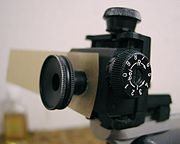
Diopter sight
Encyclopedia

Rifle
A rifle is a firearm designed to be fired from the shoulder, with a barrel that has a helical groove or pattern of grooves cut into the barrel walls. The raised areas of the rifling are called "lands," which make contact with the projectile , imparting spin around an axis corresponding to the...
s.
To obtain a usable sighting line the diopter has to have a complementing front sight element.
Diopter and globe sighting
Globe sight
A globe sight is a front sight component used to assist the aiming of a gun/device, usually those intended to launch projectiles, such as firearms, airguns, and crossbows...
lines are commonly used in ISSF match rifle shooting events.
Diopter rear sight

The typical occluder used in target shooting diopters is a disc of about 2.5 cm (1 in) in diameter with a small hole in the middle.
The small diopter viewing opening ensures the shooter's eye is very precisely and consistently centered behind the diopter sight. The diopter sight is easy to use and usually allows for very accurate aiming, because a relative long sighting line can be used. A long sighting line helps to reduce eventual angle errors and will, in case the sight has an incremental adjustment mechanism, adjust in smaller increments when compared to a further identical shorter sighting line.
High end target shooting diopters normally accept accessories like adjustable diopter aperture and optical filter systems for the aiming eye and semi-transparent occluders for the non-aiming eye to ensure optimal sighting conditions for match shooters.
Adding more simple accessories like rubber eye shields for the aiming eye to reduce/eliminate image quality impairing stray light is also often possible.
Typical modern target shooting diopters offer windage and elevation corrections in 2 mm (0.079 in) to 4 mm (0.157 in) increments at 100 m (109.4 yd). Some ISSF(Olympic) shooting events
ISSF shooting events
The International Shooting Sport Federation recognizes several shooting events, some of which have Olympic status. They are divided into four disciplines: rifle, pistol, shotgun and running target....
require this precision level for sighting lines, since the score of the top competitors last 10 shots is expressed in 0.1s of scoring ring points.
Complementing front sight element
The complementing front sight element may be a simple (hooded) bead or post for service arms, but is for target shooting more often a globe type sightGlobe sight
A globe sight is a front sight component used to assist the aiming of a gun/device, usually those intended to launch projectiles, such as firearms, airguns, and crossbows...
, which consists of a hollow cylinder
Cylinder (geometry)
A cylinder is one of the most basic curvilinear geometric shapes, the surface formed by the points at a fixed distance from a given line segment, the axis of the cylinder. The solid enclosed by this surface and by two planes perpendicular to the axis is also called a cylinder...
with a threaded cap, which allows interchangeable differently shaped front sight elements to be used. Most common are posts of varying widths and heights or rings or holes of varying diameter — these can be chosen by the shooter for the best fit to the target being used. Tinted transparent plastic insert elements may also be used, with a hole in the middle; these work the same way as an opaque ring, but provide a less obstructed view of the target. High end target front sight tunnels normally also accept accessories like adjustable aperture and optical systems to ensure optimal sighting conditions for match shooters. Some high end target sight line manufacturers also offer front sights with integrated aperture mechanisms.
Diopter and globe sighting line principle

Concentric
Concentric objects share the same center, axis or origin with one inside the other. Circles, tubes, cylindrical shafts, disks, and spheres may be concentric to one another...
circles (circles all having a common centre).
For optimal aiming and comfort the shooter should focus the aiming eye on the front sighting element. To avoid eye fatigue and improve balance the non-aiming eye should be kept open. The non-aiming eye can be blocked from seeing distractions by mounting a semi-transparent occluder to the diopter.
Even for the maximum precision, there should still be a significant area of white visible around the bullseye and between the front and rear sight ring (if a front ring is being used). Since the best key to determining center is the amount of light passing through the apertures, a narrow, dim ring of light can actually be more difficult to work with than a larger, brighter ring.
The precise sizes of the employed components are quite subjective, and depend on both shooter preference and ambient lighting, which is why target rifles come with easily replaceable front sight inserts, and adjustable aperture mechanisms.

